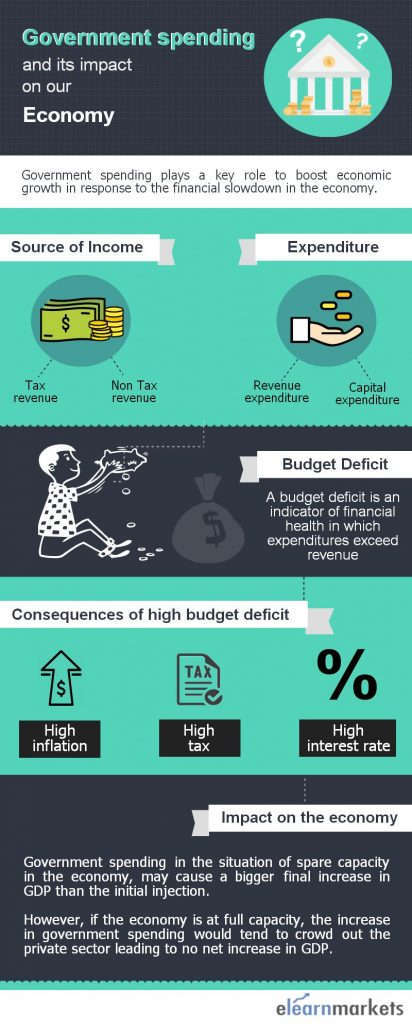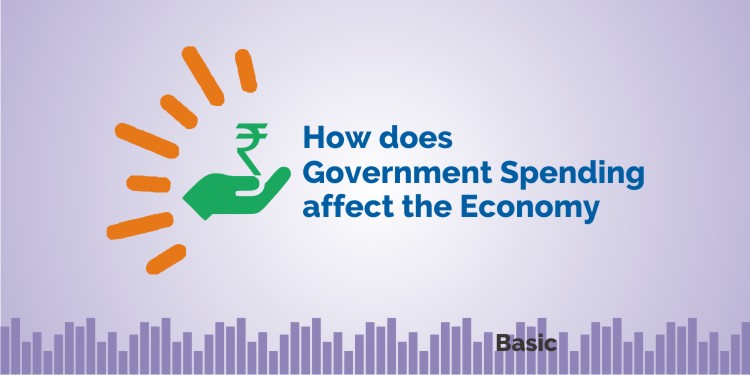In response to the financial slowdown and its impact on the economy, the government plays a key role by increasing its spending in order to boost economic growth. With so much spending going in this area, it becomes important for the policy-makers to review whether the spends made by the government is actually promoting economic growth or not.
Before we discuss the topic in-depth, you need to be familiar with the terms like fiscal deficit, government spends, economic growth to create understanding of Macroeconomics required for financial markets.
| Table of Contents |
|---|
| Key Roles of the Government |
| Sources of Income |
| Expenditure |
| Do Deficits matters? |
| Impact of government spending on the economy |
| Multiplier effect |
Key Roles of the Government
The Government has a huge role to play in the economy. Some of its key roles are as follows:
Provides a well functioning legal and political system:-
Any economy facing political or economic turmoil is not conducive to economic growth since it has very little trust in the economy. Moreover, there is uncertainty in the economy and people are also unwilling to invest. The government needs to make sure that there is a stable political environment. It’s very important on the part of the government to provide good legal and political framework.
Lays regulatory role to provide a competitive market:-
There should be certain regulations to ensure that the economy does not drift to the monopolistic situation. The government needs to think about trade policies with foreign countries, regulation on natural resources available in our country etc.
Stimulate the economy by increasing the government spending:-
This was one of the philosophies given by one of the renowned economist John Maynard Keynes. He was of the view that government’s role is very important when the economy is in recession or depression like situation and the government should increase spending to have a pickup in the economic activity.

Sources of Income:
The main sources of income for the government are Tax and Non-Tax revenue. Taxes include Income tax, Corporation tax, and Indirect taxes while the Non-Tax revenue comes from Public Sector units like income from Railways or Public sector Banks etc.
Expenditure:
The government spends can be classified as Revenue and Capital Expenditure. Revenue expenditure includes payment of salaries to government employees, payment to ministers etc. Capital expenditure leads to the formation of assets in the economy like the building of roads, bridges, schools etc.
Now since we are aware of the source of income and expenditure of the government, let’s understand about the deficit.
A Budget Deficit is an indicator of financial health in which expenditures exceed revenue. It is the sum of Revenue Account Deficit and Capital Account Deficit.
The government tries to fulfill this gap through borrowing which it does so by issuing bonds or borrowing from the foreign government.
India recorded a Government Budget deficit equal to 3.50 percent of the country’s Gross Domestic Product for the financial year ended on March 2018.
Do Deficits matters?
The understanding of government spending is not restricted to cost-benefit analysis. John Keynes in 1930’s stated that government spending boosts growth by injecting purchasing power in the economy. Keynes also believed that the government has the power to improve the situation of economic downturn through borrowing money. The government can borrow money from the private sector and return the same through different spending programs. This mechanism did not necessarily mean that government should be big.
The Keynesian theory suggested that government spending program is just to provide a short-term boost to help overcome a recession or depression like- situation in the economy. They even suggested that policymakers should be ready to reduce government spending once the economy is recovered so as to prevent inflation, which they believed would result from too much economic growth.
Fiscal deficit if kept in a check is not bad. The government in such a scenario can play the role of creating assets in the economy. These assets in the economy will benefit in the long term.
Learn theory of Economics with prevent inflation course by Market Experts
However, if the deficit is out of control it can pose a problem for the economy. Our Indian economy is mostly in deficit and in some years it has become uncomfortably high. Some of the consequences of the high Fiscal Deficit are as follows-
1. High inflation
2. High interest rate
3. High taxes in some cases
Impact of government spending on the economy
There is a high possibility that the rise in taxes will negate the impact of rising government spending which would leave Aggregate Demand (AD) unchanged. However, it is possible that increased spending and rise in tax could lead to an increase in GDP.
In a recession, consumers may reduce spending leading to an increase in private sector saving. Therefore a rise in taxes may not reduce spending as much as usual.
The increased government spending may create a multiplier effect. If the government spending causes the unemployed to gain jobs then they will have more income to spend leading to a further increase in aggregate demand. In these situations of spare capacity in the economy, the government spending may cause a bigger final increase in GDP than the initial injection.
However, if the economy is at full capacity, the increase in government spending would tend to crowd out the private sector leading to no net increase in Aggregate demand from switching from private sector spending to government sector spending.
Some economists would argue increasing government spending through higher taxes would lead to a more inefficient allocation of resources as governments tend to be less effective in spending money.
Multiplier effect
Fiscal Multiplier is often seen as a way that spending can boost growth in the economy. This multiplier state that an increase in the government spending leads to an increase in some measures of economic wide output such as GDP.
As per the multiplier theory, an initial amount of government spending flows through the economy and is re-spent over and over again which leads to the development of the overall economy. A multiplier of 1 implies that if the government created a project that takes 100 people, it would put exactly 100 (i.e. 100 x 1.0) people in the workforce.
A multiplier greater than 1 suggests more employment, and a number less than 1 means a net job loss. However, government spending may sometime decrease economic growth, possibly due to inefficient use of money.
Bottomline
Government spending, even in a time of crisis in the economy, may not work as an automatic boon for economy’s growth. Empirical evidence suggests that in practice, government outlays designed to stimulate the economy may fall short of that goal.
So before it approves any additional spending to boost growth, the government should have an understanding whether such spending is likely to stimulate growth and report how much uncertainty surrounds those estimates.
Moreover, this analysis should be opened to the public for comment prior to it is applied in the system.







Great article about realtors